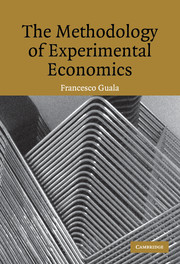Book contents
- Frontmatter
- Contents
- Analytical Table of Contents
- Acknowledgments
- 1 Introduction
- PART ONE INFERENCES WITHIN THE EXPERIMENT
- PART TWO INFERENCES FROM THE EXPERIMENT
- 7 External Validity
- 8 Economic Engineering
- 9 From the Laboratory to the Outside World
- 10 Experiments as Mediators
- 11 On Monetary Incentives
- Appendix A
- Appendix B
- Bibliography
- Index
9 - From the Laboratory to the Outside World
Published online by Cambridge University Press: 10 December 2009
- Frontmatter
- Contents
- Analytical Table of Contents
- Acknowledgments
- 1 Introduction
- PART ONE INFERENCES WITHIN THE EXPERIMENT
- PART TWO INFERENCES FROM THE EXPERIMENT
- 7 External Validity
- 8 Economic Engineering
- 9 From the Laboratory to the Outside World
- 10 Experiments as Mediators
- 11 On Monetary Incentives
- Appendix A
- Appendix B
- Bibliography
- Index
Summary
Mechanism design is applied science carried out under the most favorable conditions – in conditions that maximize the chance of successfully exporting experimental results outside laboratory walls. In this chapter, I try to generalize from this particular case to provide an account of external validity inferences in less than ideal circumstances. Scientists, as a matter of fact, do draw inferences from experiments, even when the outside world cannot be shaped to resemble laboratory conditions. I introduce a new example from auction theory in which the procedure is exactly symmetrical to the one followed by the FCC consultants: the laboratory conditions were shaped so as to resemble those of a real-world economy, instead of the other way around. I also draw some analogies from experimental medicine and elaborate on the role of laboratory and field evidence in external validity inferences. Before doing that, however, I have to dispose of a disturbing and extreme stance on the external validity problem, which I label “radical localism.”
Radical localism
The cathodic rays that make our TV sets function are generated by a carefully engineered causal structure that has been repeatedly tested in laboratory conditions, then in the factory, and finally stabilized, “shielded” within a plastic box, and sold to customers all over the world. With few exceptions (e.g., Cartwright 1999), philosophers of science have neglected this pervasive feature of applied science (or “techno-science,” as it is sometimes called): success is usually achieved as much by construction as by accurate representation.
- Type
- Chapter
- Information
- The Methodology of Experimental Economics , pp. 184 - 202Publisher: Cambridge University PressPrint publication year: 2005

